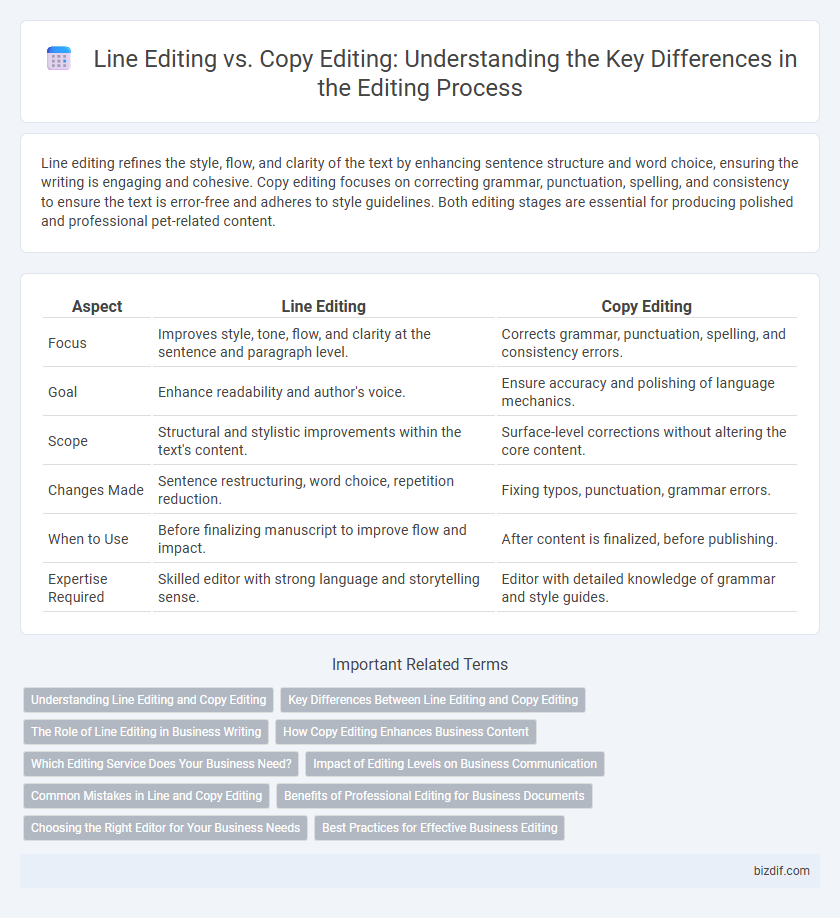Line editing refines the style, flow, and clarity of the text by enhancing sentence structure and word choice, ensuring the writing is engaging and cohesive. Copy editing focuses on correcting grammar, punctuation, spelling, and consistency to ensure the text is error-free and adheres to style guidelines. Both editing stages are essential for producing polished and professional pet-related content.
Table of Comparison
| Aspect | Line Editing | Copy Editing |
|---|---|---|
| Focus | Improves style, tone, flow, and clarity at the sentence and paragraph level. | Corrects grammar, punctuation, spelling, and consistency errors. |
| Goal | Enhance readability and author's voice. | Ensure accuracy and polishing of language mechanics. |
| Scope | Structural and stylistic improvements within the text's content. | Surface-level corrections without altering the core content. |
| Changes Made | Sentence restructuring, word choice, repetition reduction. | Fixing typos, punctuation, grammar errors. |
| When to Use | Before finalizing manuscript to improve flow and impact. | After content is finalized, before publishing. |
| Expertise Required | Skilled editor with strong language and storytelling sense. | Editor with detailed knowledge of grammar and style guides. |
Understanding Line Editing and Copy Editing
Line editing focuses on enhancing the style, tone, and flow of sentences by refining word choice, rhythm, and clarity to ensure the text resonates effectively with the reader. Copy editing, on the other hand, targets grammar, punctuation, spelling, and consistency to prepare the manuscript for publication by eliminating errors and improving readability. Understanding these distinct processes helps writers prioritize revisions that polish expression in line editing while ensuring technical accuracy in copy editing.
Key Differences Between Line Editing and Copy Editing
Line editing focuses on enhancing sentence structure, tone, and flow to improve readability and style, while copy editing addresses grammar, punctuation, spelling, and consistency errors for correctness. Line editors work primarily at the sentence and paragraph level, refining language and narrative voice; copy editors concentrate on adherence to style guides and factual accuracy. Understanding these key differences ensures tailored revisions that elevate both the clarity and professionalism of a manuscript.
The Role of Line Editing in Business Writing
Line editing sharpens business writing by enhancing clarity, flow, and tone to engage target audiences effectively. It refines sentence structure, word choice, and style consistency, ensuring the message aligns with brand voice and corporate objectives. Focus on line editing elevates professionalism and readability, driving better communication outcomes in marketing materials, reports, and proposals.
How Copy Editing Enhances Business Content
Copy editing enhances business content by ensuring clarity, consistency, and accuracy, which builds trust with clients and strengthens brand reputation. It corrects grammar, punctuation, and style errors while aligning the text with the company's tone and messaging standards. Effective copy editing improves readability and professionalism, driving better engagement and conversion rates.
Which Editing Service Does Your Business Need?
Line editing enhances clarity, flow, and tone by refining sentence structure and word choice, making it essential for businesses aiming to engage readers with polished content. Copy editing ensures grammatical accuracy, corrects punctuation, and enforces style consistency, vital for maintaining professionalism and credibility in business communications. Choosing between line editing and copy editing depends on whether your business needs to improve the overall readability and voice of the text or focus on error-free, standardized documents.
Impact of Editing Levels on Business Communication
Line editing enhances business communication by improving clarity, tone, and flow, ensuring messages resonate effectively with the target audience. Copy editing focuses on accuracy, grammar, and consistency, maintaining professionalism and credibility in corporate documents. The combined impact of both editing levels results in polished content that drives engagement, fosters trust, and supports brand reputation.
Common Mistakes in Line and Copy Editing
Common mistakes in line editing include inconsistent tone, overlooked awkward phrasing, and failure to enhance sentence flow. Copy editing errors often involve missed punctuation errors, improper grammar corrections, and inconsistent style or formatting adherence. Both editing types require meticulous attention to detail to maintain clarity, coherence, and correctness in the manuscript.
Benefits of Professional Editing for Business Documents
Professional editing enhances business documents by ensuring clarity, coherence, and accuracy, improving overall communication effectiveness. Line editing refines sentence structure and style, making the content more engaging and polished, while copy editing corrects grammar, punctuation, and consistency errors to maintain professionalism. Combining both editing types results in documents that effectively convey messages, build credibility, and support business success.
Choosing the Right Editor for Your Business Needs
Line editing focuses on enhancing sentence structure, tone, and clarity to ensure the text flows smoothly and engages the target audience effectively. Copy editing primarily addresses grammar, punctuation, spelling, and consistency to prepare the manuscript for publication without altering the author's voice. Choosing the right editor depends on whether your business needs emphasize stylistic refinement and readability or precise language correction and adherence to publication standards.
Best Practices for Effective Business Editing
Line editing focuses on enhancing sentence structure, tone, and flow to ensure clarity and engagement, while copy editing targets grammar, punctuation, and consistency for accuracy and professionalism. Best practices for effective business editing include maintaining a clear brand voice, ensuring factual accuracy, and adhering to style guides such as the Chicago Manual of Style or APA. Utilizing thorough proofreading tools alongside human review guarantees error-free and polished business documents.
Line Editing vs Copy Editing Infographic

 bizdif.com
bizdif.com